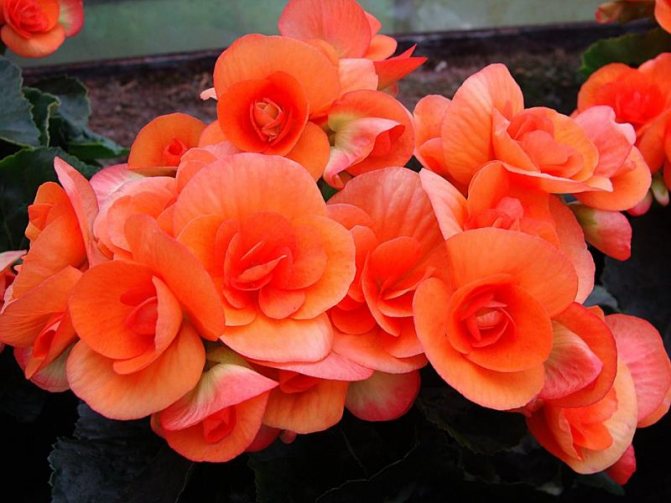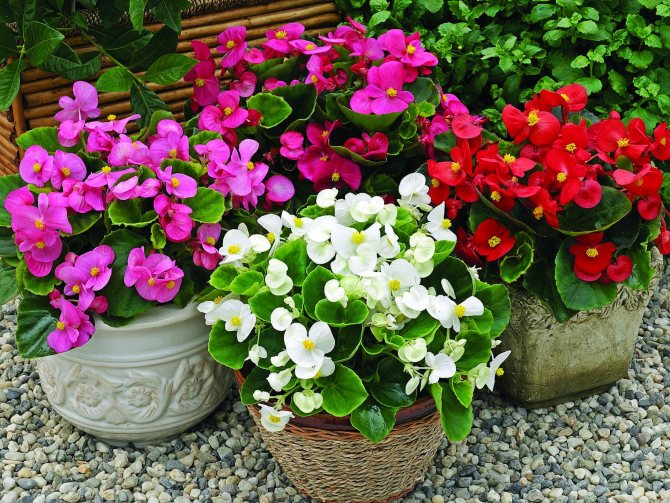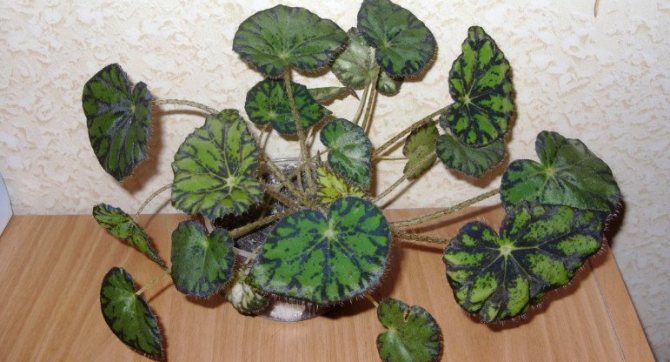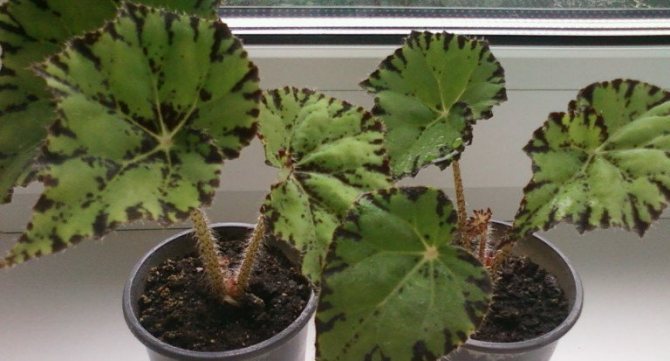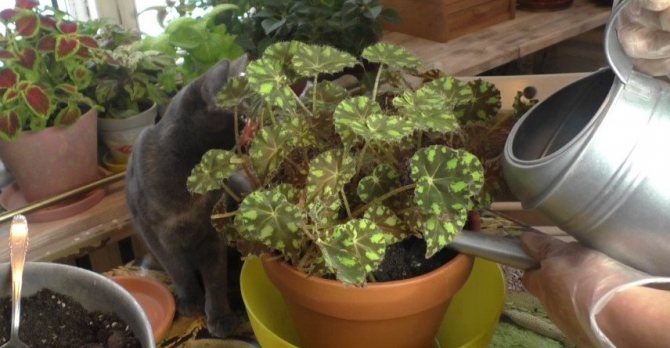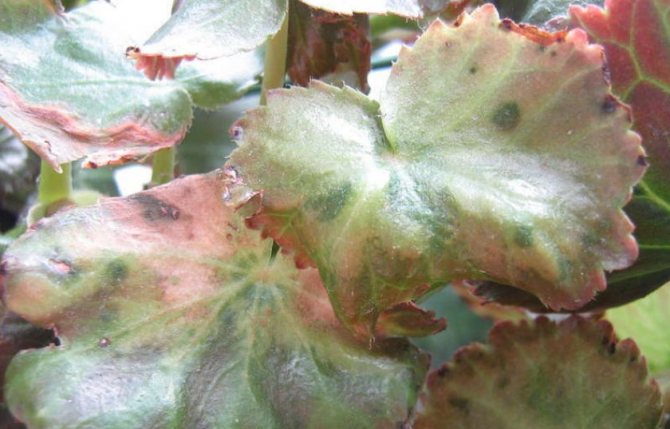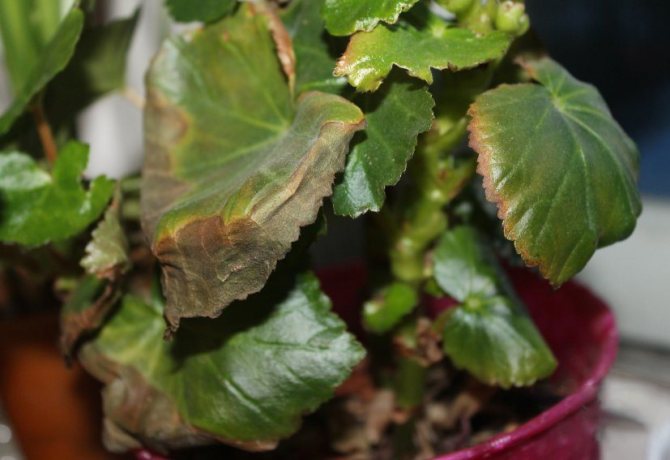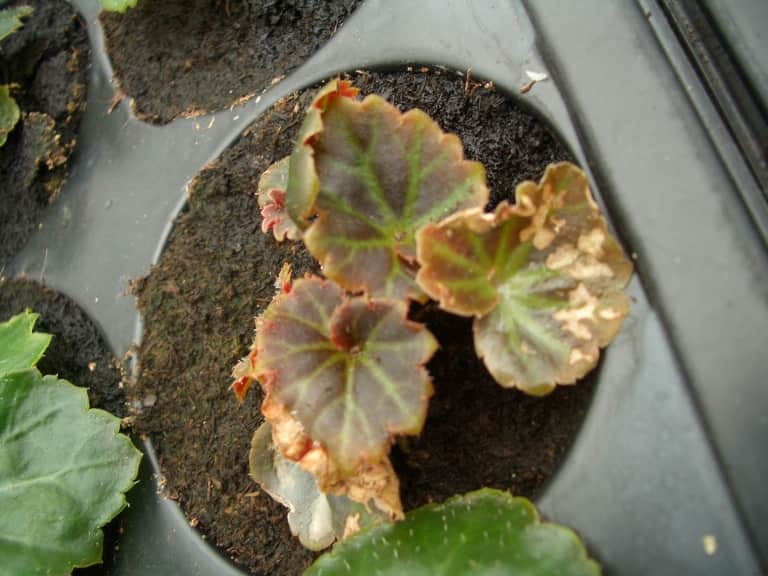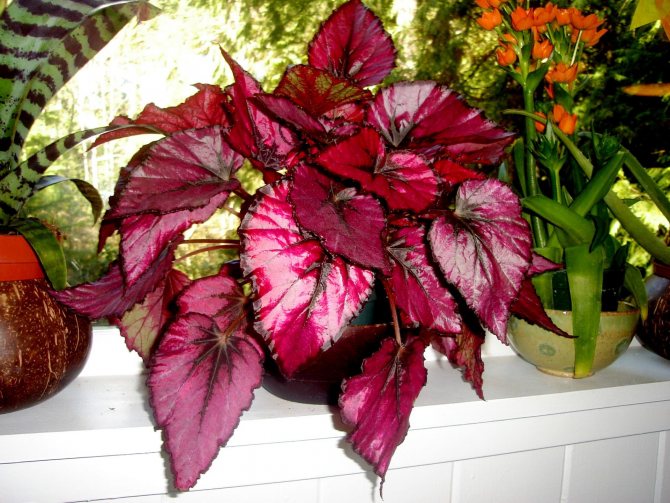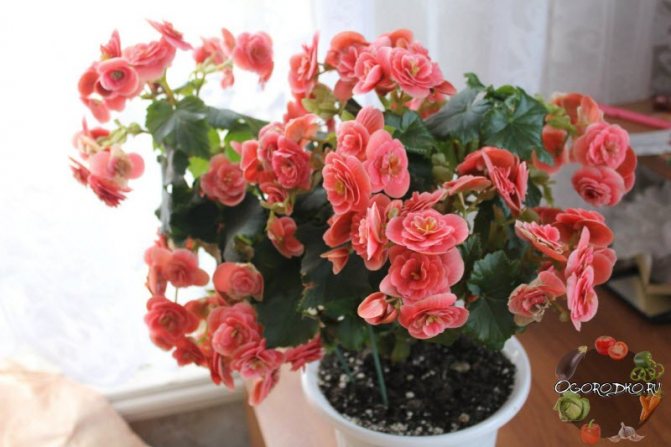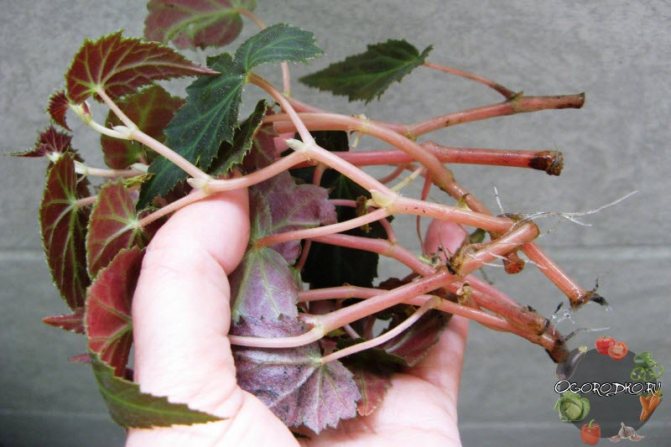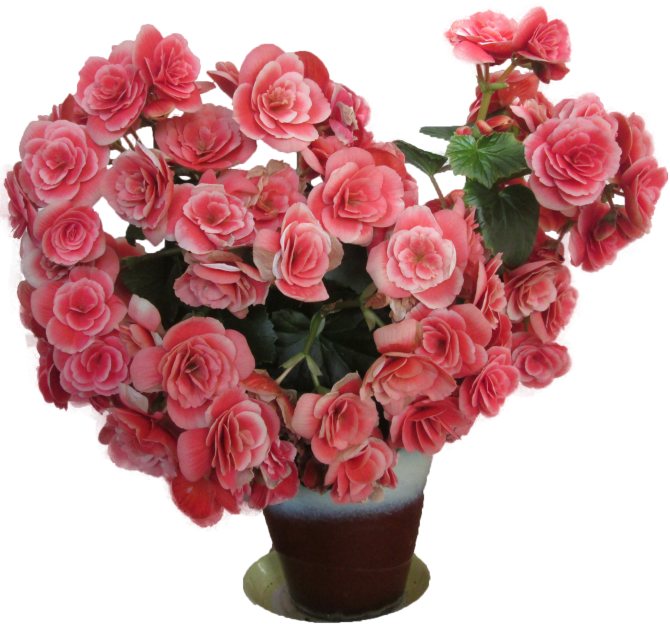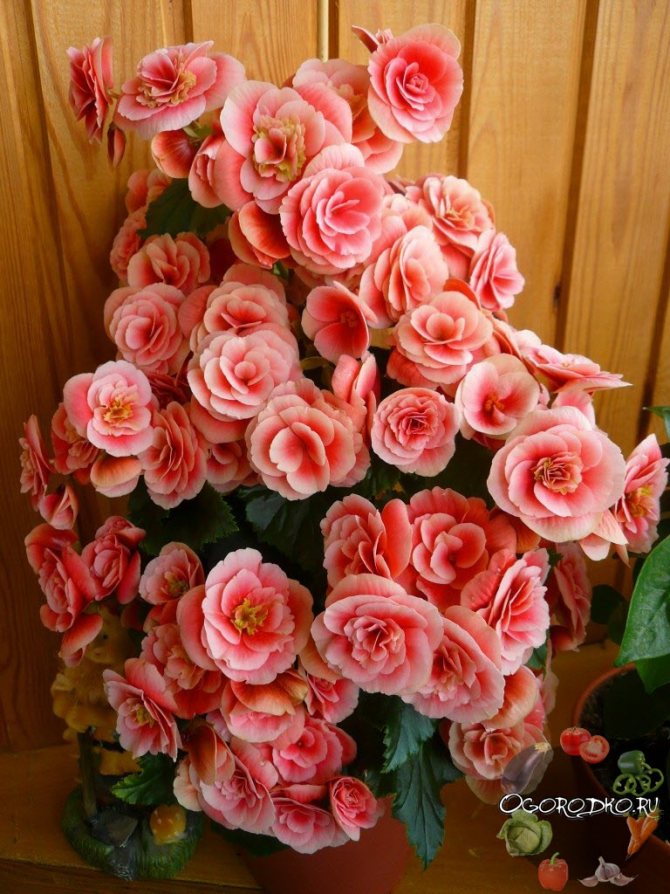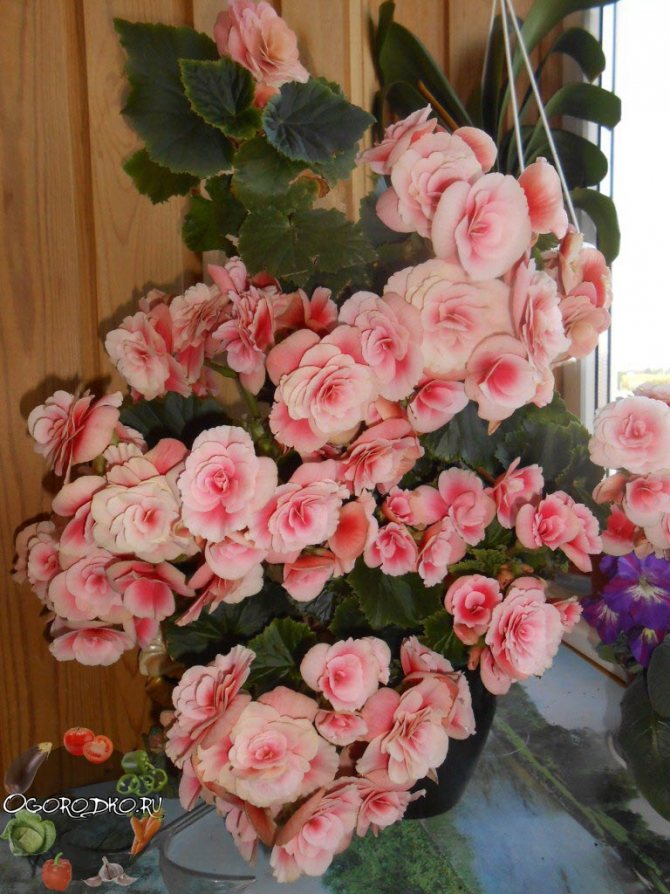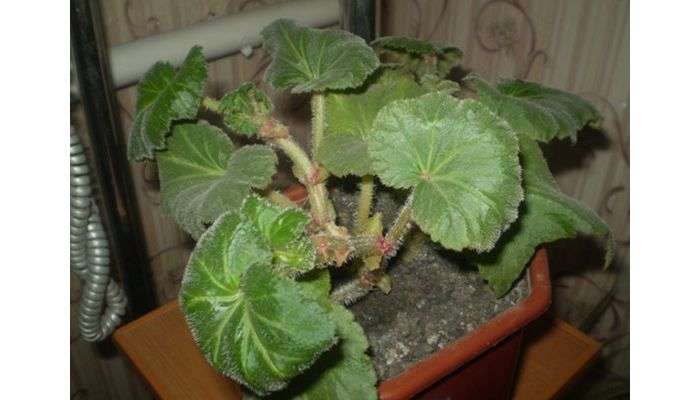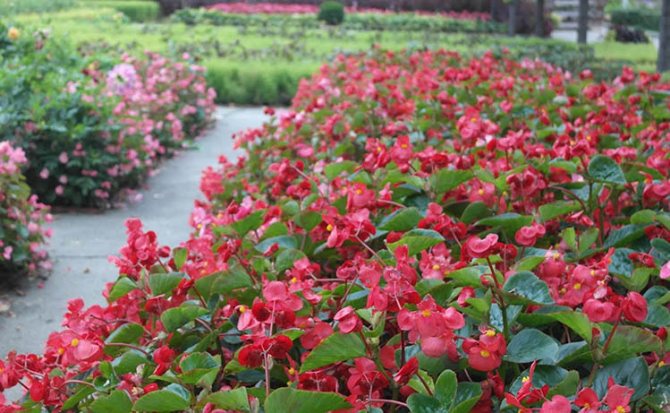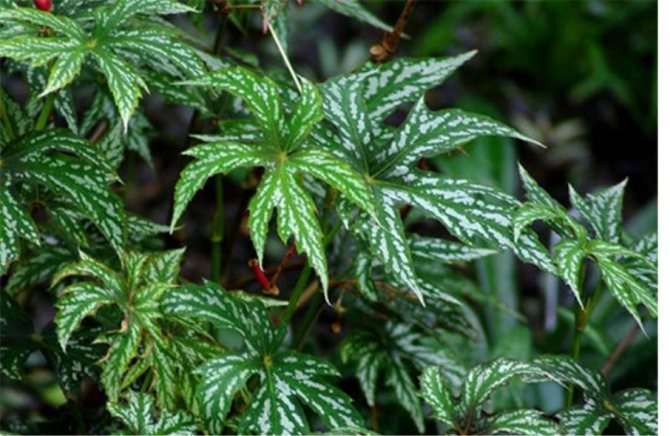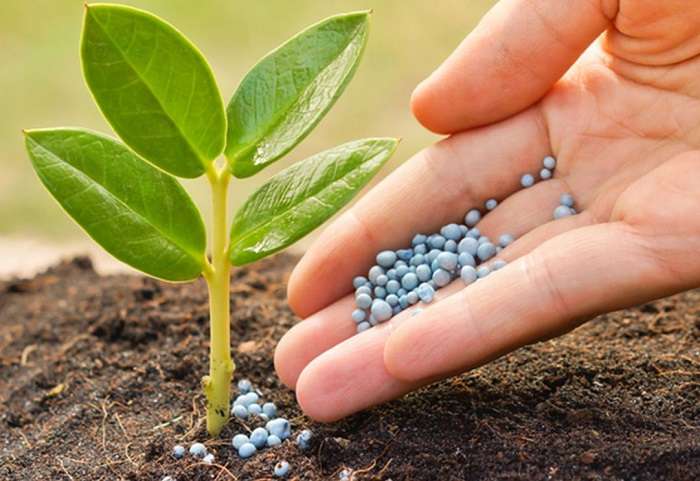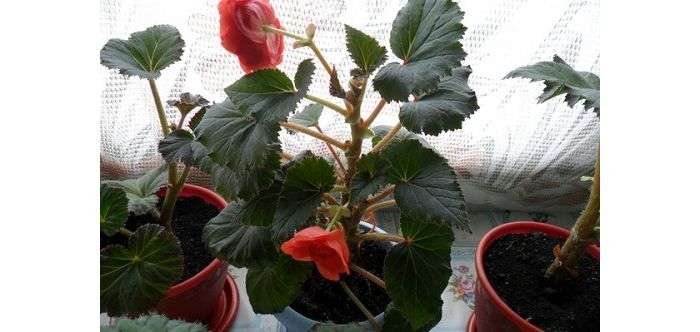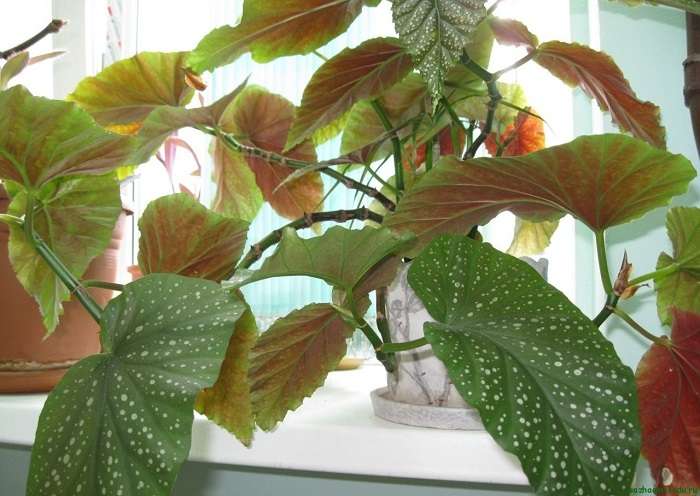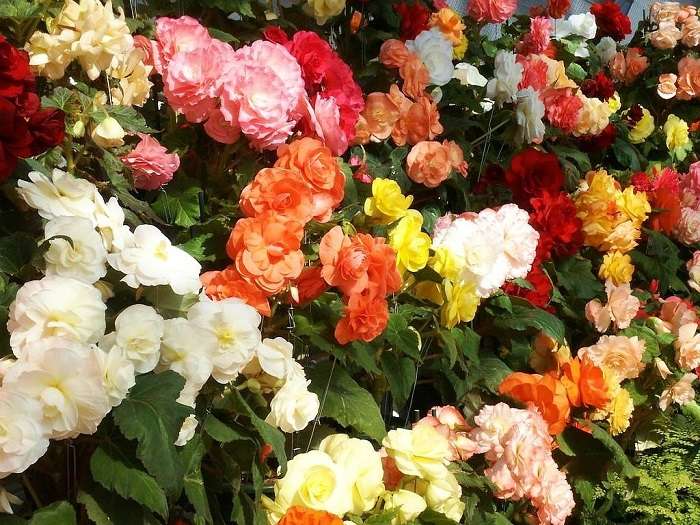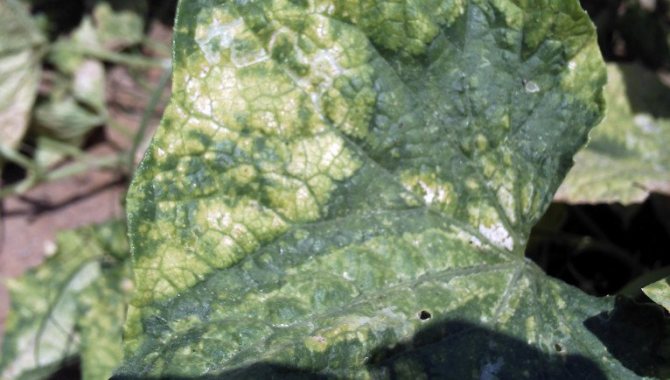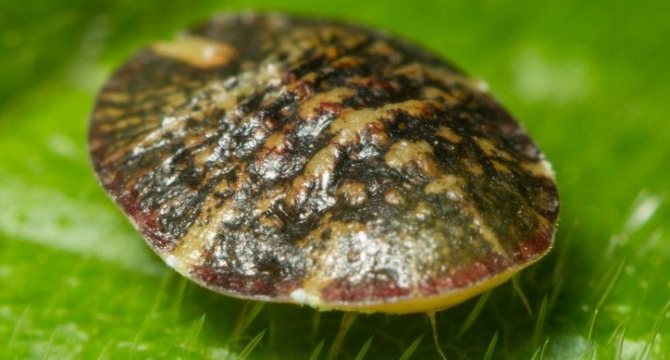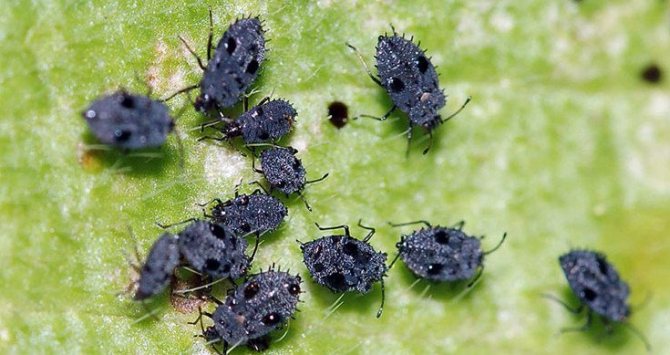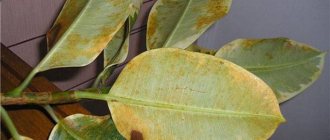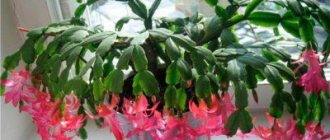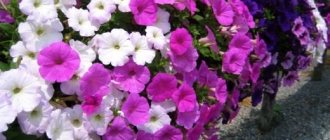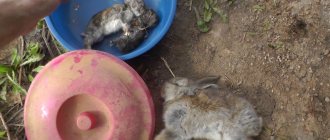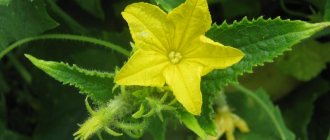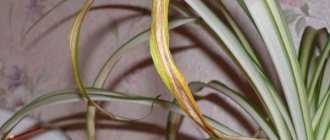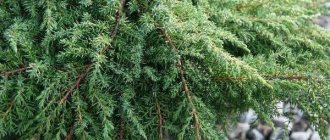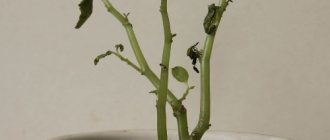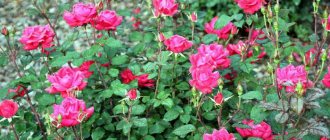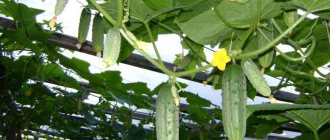Begonias are annual and perennial indoor plants in the form of shrubs and semi-shrubs belonging to the family of the same name. These crops are characterized by an asymmetric leaf shape and a multi-colored color of the flower-bearing parts. Blooms are brightly colored, have an irregular shape, and the fruits develop in the form of bolls. Depending on the variety, plants reproduce by dividing rhizomes or tubers.
Why you need to prune begonia
First of all, pruning begonias is needed for lush flowering and rejuvenation of the culture. Through this procedure, old and dry shoots are removed, the correct crown shape is formed, and the quality of flowering improves. With regular pruning, the correct ratio between the crown and the root system of the plant is ensured.
After transplanting a young plant, the first pruning is performed when it reaches a height of 7-8 cm. At the same time, the future shape of the crown should be determined, based on which certain parts of the branches are cut.
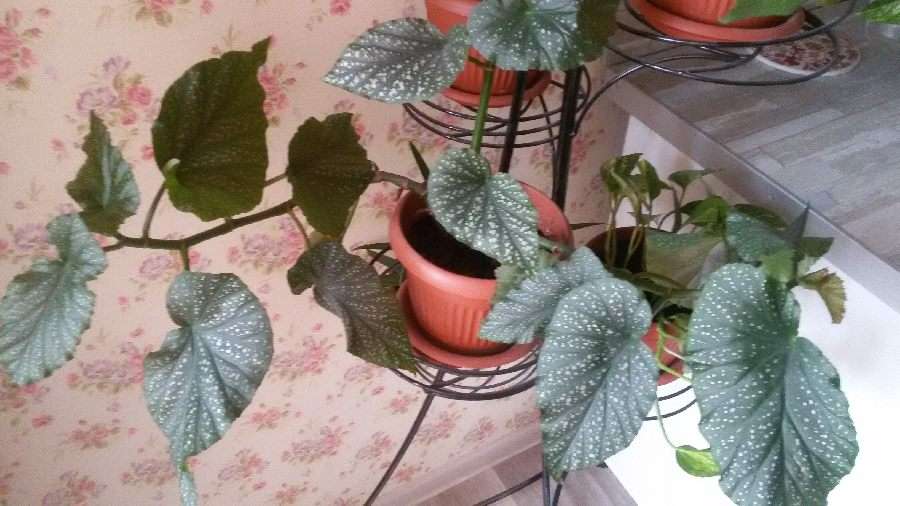
When the lateral shoots reach a length of 10-12 cm, their upper parts are carefully cut, thereby stimulating the development of lateral buds and contributing to the formation of a beautiful, rich bush. Further steps for the care are the timely removal of bent, dried shoots.
Features of begonia care during flowering
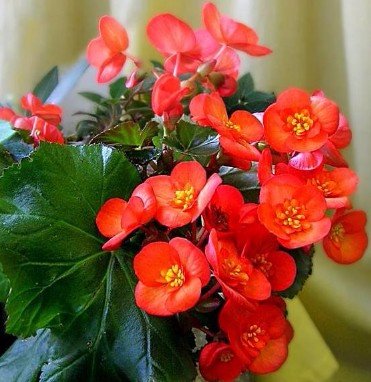

Many people wonder how to feed begonias for abundant flowering.
During flowering, begonia must be fed at least once a week.
To do this, use mineral fertilizers, but before that it is best to add a weak solution of potassium nitrate.
Important!
If you want to prolong flowering, prune the wilted flowers as often as possible.
When the begonia finishes flowering, prepare the plant for the resting phase. To do this, reduce the amount of watering until the aboveground part dries. Cut off withered leaves, stems, shoots and flowers. The temperature should be no higher than 12 ° C. The dormant period lasts from November to March.
What kinds of begonias need pruning?
Pruning begonias at home is a responsible procedure that requires care and accuracy from the grower. When working, plant varieties are taken into account: some do not require such treatment at all, while others need regular and fairly frequent treatment to stimulate growth in width.
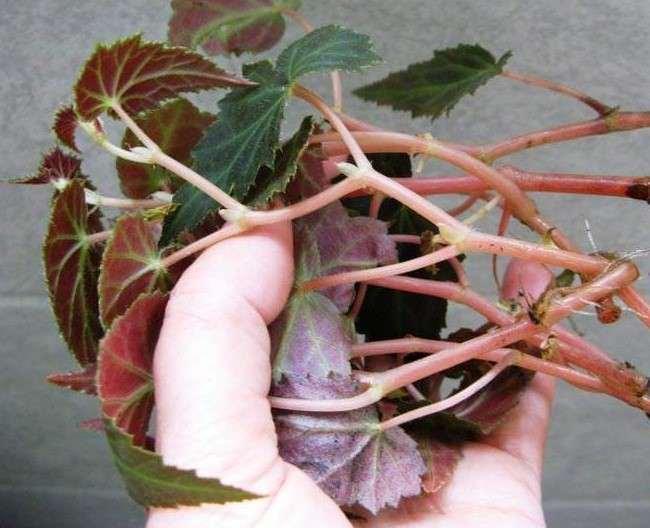

In the spring, bush plant varieties are predominantly thinned out, then begonias begin to grow actively. But as to whether it is necessary to prune begonias for the winter, experts have different opinions. For example, tuberous varieties need this procedure in mid-autumn, and until March the plant rests and recovers.
Begonia varieties such as royal rex, ever-flowering varieties and their hybrids are necessarily pruned. For thick-stemmed varieties, the procedure is done if necessary. And in ampelous begonias, only the apical stems are removed, thus stimulating the development of lateral shoots. Shrub varieties are usually cut in the spring when the plant sheds old foliage.
Is pruning necessary in winter?
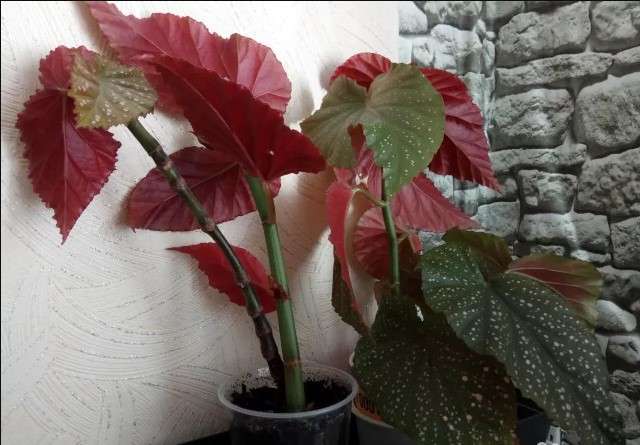

In the autumn period, begonias pass into a passive vegetative period, so the number of waterings is reduced, and the ground parts with dried leaves are removed. Ideal conditions for wintering: a dark, cool place where the air temperature does not exceed 15 degrees. At the beginning of spring, when the growth of young leaves begins to be observed, the flowers come out of a state of dormancy, they can be returned to their usual places.
What is cropping?
One of the properties of plants is their unlimited growth in the presence of the necessary nutrients in the soil. Over time, indoor flowers lose their attractiveness due to the proliferation of branches, become sloppy and cease to please the eye. Old branches lose strength and take away juices from young ones, preventing them from developing.
For rejuvenation and refinement of begonias, pruning is used - the removal of certain shoots and limiting the growth of new ones.
Cutting off excess stems improves the appearance, stimulates the growth of young shoots, and allows you to maintain a balance between the aboveground and underground parts. In flowering plants, pruning helps to form a flowering crown, remove excess flowers, or even trim the peduncle to maintain vitality. Pinching differs in that only a small tip of the shoot is removed... When the apical (apical) kidney is cut off, the so-called "spare" lateral ones wake up.
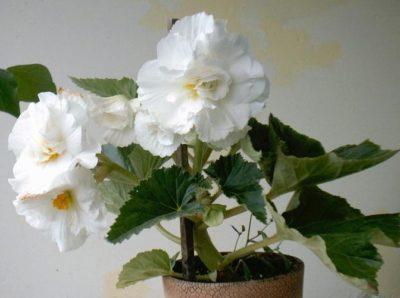

Pinching is used to increase the branching of the plant, and pruning is used to rejuvenate and form the crown.
Pinching in begonias is done when it is not possible to prune - for example, in very young plants.
Young bushes have not yet formed old shoots that need to be pruned. Pinching allows you to form a crown of the required shape.
Bush varieties need pruning, as they tend to grow rapidly and the leaves become shorter.
How to properly form a begonia bush
The growth rate and quality of flowering is directly determined by how correctly the begonia bush is cut and how it is formed. This should be taken care of even at the stage of early development:
- The first such procedure is performed when the plant reaches a height of 7-8 cm.
- In the subsequent period, the amount of watering decreases, it resumes when the flower begins to grow.
- After the begonia is pruned after flowering, the upper parts of the shoots that have reached a length of more than 10 cm are removed.
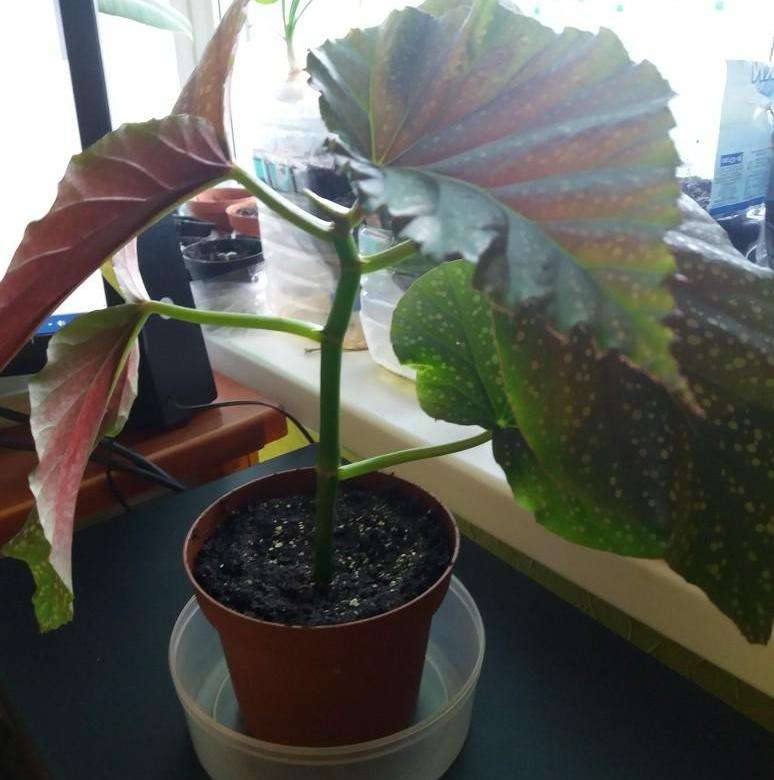

The desired crown shape is maintained by periodically shortening the elongated stems and removing dried shoots.
Favorable conditions for growing home begonia
Begonias are unpretentious to care for and disease-resistant, but the question of how to grow begonias is very common. You need to remember three rules for caring for a plant: transplanting, timely feeding and moderate watering.
This will be discussed in the following sections.
Did you know?
The plant was named after the Governor of Haiti - M. Begon.
Lighting
In order for begonia to please with abundant flowering, you need to provide the plant with good lighting, best diffused. Make sure that the begonia leaves are not exposed to direct sunlight - this causes burns on them. If you do not have the opportunity to grow begonia on a windowsill, you can use phytolamps. It is more efficient to use two phytolamps.
Temperature
Begonia feels great at room temperature. If the temperature drops below 16 ° C or exceeds 28 ° C, leaves and flowers wilt and fall off.
Air humidity
Begonias need high air humidity - about 60%.
In winter, additional air humidification is required. This can be achieved by spraying. Dry and cool conditions are good for tuberous begonias. They do not need high humidity. Shrub species are tolerant of dry air in winter, but it doesn't hurt to spray them either.
Leaves fall: diseases and pests
Why do orchid leaves wither: causes and methods of dealing with them
Begonia leaves can fall off due to the appearance of downy mildew or pernosporosis - a fungal disease. Pathogens are found in the ground. There are more of them when soil and air moisture increases. The disease spreads very quickly and leads to the fall of the greenery.
Begonia pests are small in size. However, they can lead to the death of the plant. Here are the parasites that lead to leaf litter:
- greenhouse whitefly. It is a very small butterfly with a length of 1.5 mm. It settles on the leaves and actively begins to multiply on them, feeding on their juices. It is possible to eliminate the insect with a regular soap solution. The larvae must be removed by hand;
- leaf and root nematodes. Leafy species settle on stems, leaves and buds, gallic ones - on the roots and at the bottom of the stem. Nematodes are worms that are microscopic in size. As a result of their activity, the plant dies. First, light green spots appear, which turn brown and swell over time. It is better to prevent nematodes than to fight them. The land in which begonia is planted must be steamed;
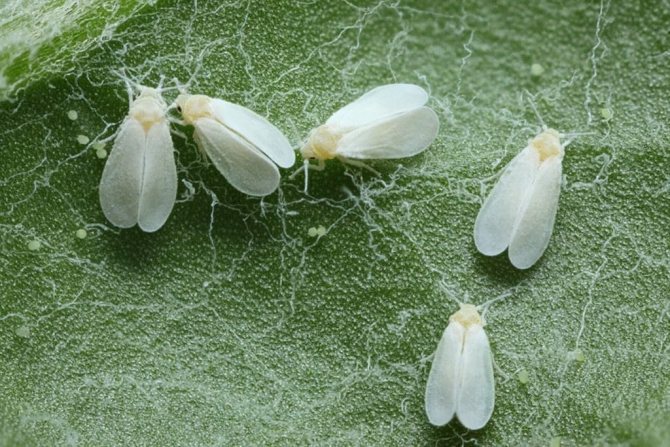

What does a greenhouse whitefly look like?
- false scale. This pest hides inside the plant. The flower stops growing, the leaves turn yellow and dry out. It is necessary to fight the pest by scrubbing with a brush dipped in an infusion of garlic. Only those parts of the plant that are affected by pests are processed;
- red spider mite. If a thin web envelops the flower, then a spider mite has appeared on it. It reproduces in hot and humid conditions. At first, the leaves become marbled in color, and then turn yellow and fall off;
- greenhouse aphid. This pest reproduces very actively. The female produces up to 100 insects every week. They suck out juices. To overcome aphids, it is necessary to spray the plant with tobacco infusion;
- greenhouse thrips. They are quite large in size. The leaves lose color and the plant begins to wither. Thrips breed in conditions of high humidity and temperature.
When to pinch begonia
The pinching procedure can be performed twice a year:
- in the spring, always before the beginning of budding;
- in summer, immediately after all flowers have fallen off.
Petunias ampelous - when and how to pinch
Also, pruning and pinching are carried out as the branches are pulled out. What if the begonia is stretched out? Cut it off urgently. The formation is carried out regularly and gradually. The first time such procedures are done immediately after purchasing a flower, having previously determined the shape of the flower.
Remember! Transplanting and pruning cannot be carried out at the same time. The plant may not stand up to double stress.
If there is no constant care for the plant, then it grows and turns into a formless "something". In addition to the nondescript appearance, there is a depletion of the stem and shoots. Leaf plates are reduced, flowers do not form or become very small.
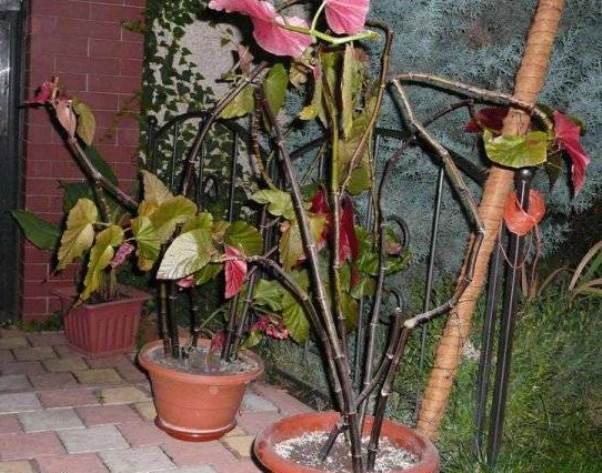

Unkempt plant
In late autumn, before winter pruning, it is necessary to significantly reduce the frequency and intensity of watering the flower. When the first signs of leaf drying appear, the entire aerial part is cut off. Above ground level, you must leave no more than 2 cm of the stem. The place for wintering is selected as carefully as possible: the temperature in the room should not be higher than +15 degrees; complete lack of sunlight is encouraged.
Important! The tubers of an adult plant can be stored in winter not only in the flower pot in which it grew. Most often, flower growers use boxes with dry sand and peat for these purposes.
You can use the basement, a darkened loggia, or hide the flower in the closet. Even during the dormant period, begonias must be observed: the soil must not be allowed to dry out. Florists advise pruning in October.For a normal rest of an adult plant, you need at least six months. The awakening of the flower occurs, as a rule, at the very end of February or at the beginning of March.
Remember! The growth of a young flower practically stops in winter. The ability to preserve stems and leaves is inherent only in some types of begonias.
Diseases of indoor begonias
Often, the lack of flowering serves as an alarm signal that the plant is affected by fungus or rot. Tropical crops cannot stand a violation of the irrigation regime, improper agricultural techniques in the dormant phase. Tuberous begonias are most often affected by rot when wintering too cold.
Before planting tubers in flowerpots, you should carefully examine the planting material and remove the affected parts to healthy tissue.
Sections are treated with disinfectants. Sometimes rot affects the aerial part of the plant. The reason for this is waterlogging of the substrate or waterlogging of the soil. It is important to control the moisture content of the substrate and not water the specimen until the topsoil dries. Waterlogging of the soil occurs when there is a poor-quality drainage layer.
The drainage mixture should occupy at least a quarter of the planting tank volume. Expanded clay and broken brick cannot be used as a drainage filler, since these materials accumulate moisture. Attention should be paid to the number and size of drainage holes in the bottom of the flowerpot.
Flower pests of begonias
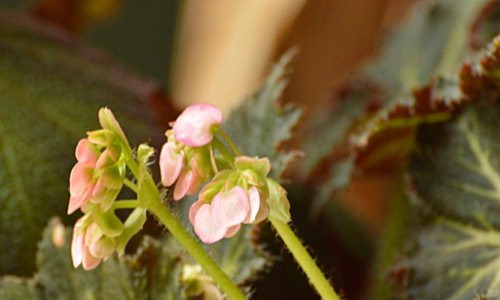

The defeat of a houseplant by flower pests can cause the lack of flowering. The vegetation of a tropical bush is disrupted, since all types of pests feed on the juice or begonia tissue. A careful examination of the leaves and petioles allows one to establish that the specimen has been attacked by pests.
Most often begonias affect:
- Aphid;
- Spider mite.
Aphids live on the lower part of the leaf plates and look like a slight raid to the naked eye. Microscopic insects of light green or whitish color can be seen under a magnifying glass.
Thin cobwebs in the area of the lower part of the leaves may indicate the presence of a spider mite. It is recommended to carefully remove the affected parts of the plant, and then carry out preventive treatment of begonias. The problem is solved through the use of insecticides. Chemicals are sold by specialized outlets. The aerial part of the plant is treated according to the instructions on the package. You should remember about personal safety.
Sometimes the cause of the death of a plant is soil infected with nematodes. Rehabilitation of the affected specimen is almost impossible. Nematodes belong to the class of protozoa. Experienced flower growers recommend getting rid of the soil along with the specimen and the flowerpot.
What is this houseplant?
Begonia is the name of a genus of plants from the family of the same name. It can be herbaceous, semi- or shrub. All representatives of the genus have asymmetric leaves with a heavily cut leaf plate. It transforms during the flowering period. After pollination, buds of different colors and shades open on the peduncles.
On a note. All flowers are bright, they have an irregular shape. They are unisexual and monoecious. Some begonias are tuberous, while others have rhizomes, but the fruit is always a box.
For the first time, begonias were spoken about in Europe at the end of the seventeenth century. Then scientists unexpectedly came across evergreen begonia in the New World, a little later - on the royal one. In the jungles of South America, a tuberous plant species was discovered.
How to pinch: ways
Pinching is performed to give a certain shape to the crown of the plant. It can be a ball, pyramid or bush.
To give bushiness, you need to perform the following actions:
- For the first time, pinch off the top at a height of 5 cm. This procedure stimulates and accelerates the growth of lateral shoots.
- When the lateral stems reach 12 cm, the procedure is repeated.
- When the desired result is obtained, you need to cut out the inner branches and side shoots from time to time. This will help keep the begonia in shape for a long period.
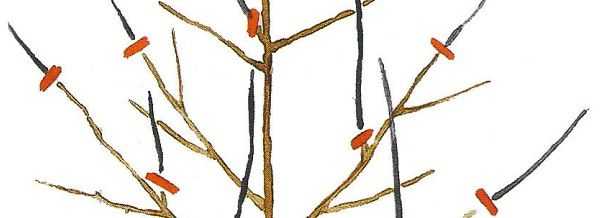

Cutting technology
To figure out how to properly prune begonia, you need to understand in what cases it is needed:
- Pruning of flowering shoots is carried out in ornamental plant varieties.
- When dry and damaged branches and leaves appear, they must be urgently removed. This procedure is carried out to avoid the appearance of diseases and pests.
- Pruning a flower before winter is a prerequisite for any plant that is dormant in cold weather.
Advice! If the begonia has stopped growing for some unknown reason, you need to cut off the bud on the upper stem in order for the growth process to resume.
How to properly care after a cut?
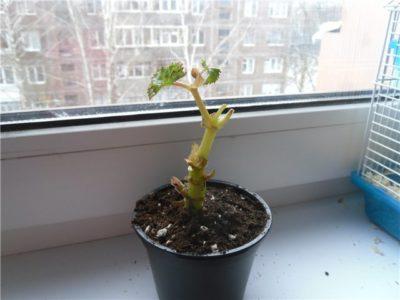

After pruning, it is enough to follow the basic rules of care.as before circumcision. Let's tell you more about them.
The most favorable temperature range is from 13 to 22 degrees Celsius, but do not forget to maintain a stable air humidity. The optimum humidity level is 60 percent. Since our begonia is a herbaceous species, the state of dormancy lasts from October to February.
To transfer the plant to this state, watering is reduced and wilted shoots are cut off. Some experts advise storing begonia tubers in the dark at a temperature of 10 to 12 degrees Celsius for up to two months. The best growth properties appear when the plant is in partial shade. Watering is carried out only after the top layer of the earth has completely dried.
To provide begonias with the necessary moisture, the pot should be placed on a tray of water., but so that the pot itself is not in the water, or placed on wet peat.
If the humidity level is too high, begonia will rot, so do not overdo it. On hot summer days, the air around the begonias is sprayed, but so that water does not get on the leaves. The room in which the begonia is located must be periodically ventilated, but so that the plant itself does not blow through with a draft. Transplantation is carried out only in cases of extreme necessity.
In conclusion, I would like to say that circumcision and pinching of begonia are very important procedures, which will both increase the splendor and decorativeness of begonias, and extend its life. In addition, these procedures are so simple that any novice florist who has never even approached begonias can do them.
The process itself will also be useful in the future, when pinching and cutting off other plants, because in fact the technology is the same.
If you find an error, please select a piece of text and press Ctrl + Enter.
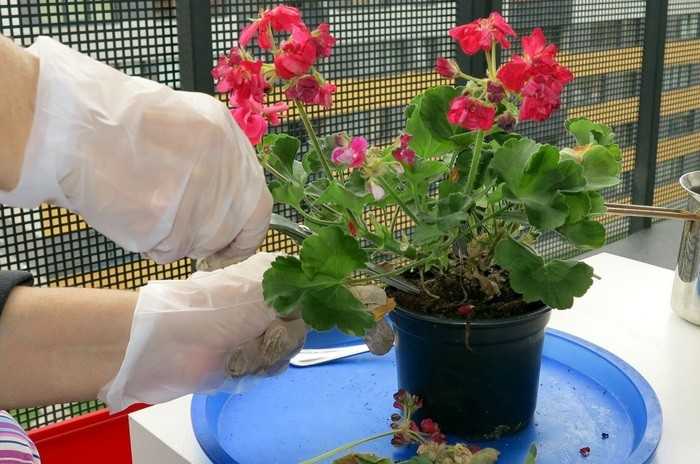

Pruning begonias it is necessary to carry out for bush varieties. Those that are thick-stemmed are only pruned when the plant is old. Ampel and tuberous varieties are not pruned.
Features of begonia care in winter
In our climatic conditions, the question of how to organize proper care for begonias in winter will be reasonable.
In winter, begonia needs sunlight. To do this, you should expose the pot with the plant on a windowsill in the sun for several hours. Watering should be moderate, but the soil should be constantly moist.
Important!
Do not over-water the plant, this will lead to root rot.
In winter, the plant slows down in growth and requires rest. In this case, feeding and transplanting should be postponed until spring.
Pinching tools
How to transplant begonia to a new location
Experienced growers advise cutting and pinching using only sharp tools.For these purposes, you can use a knife, scissors or garden pruner. It is strongly not recommended to use ordinary office scissors for trimming and pinching. The use of unsuitable tools can cause plant disease.
On a note! Pinching with your hands can damage the stem.
Useful video
Video with details of pruning Begonia:
Useful material Below is a list of articles that might interest you.
If you find an error, please select a piece of text and press Ctrl + Enter.


Begonia has been one of the most common indoor plants since the mid-16th century, when begonia itself was introduced to Europe. Since that time, this plant has been very popular among flower growers, it is used to decorate all kinds of parks, gardens and squares.
The question is often asked: is it worth pruning begonias, and if so, how and when to do it correctly. Further, we will talk in detail about pruning, with a full analysis of the process.


